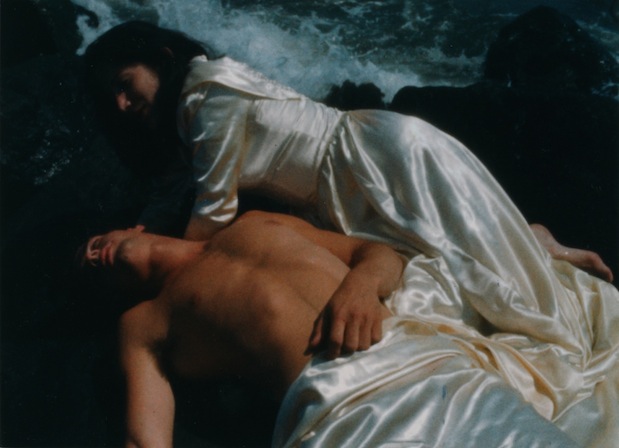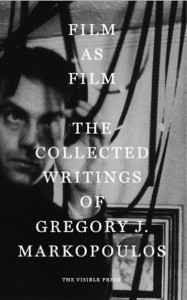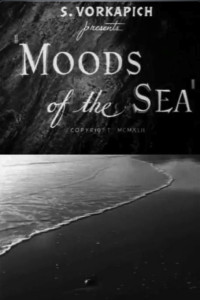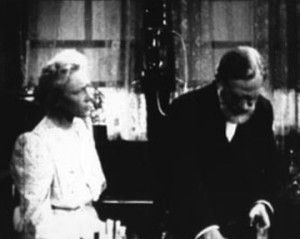Click here to print
Films by Gregory J. Markopoulos and Four Other Avant-Gardists Win Preservation Grants
posted November 3, 2015

Gregory Markopoulos: Twice A Man (1963)
Paul Kilb and Olympia Dukakis in Twice A Man (Gregory Markopoulos, 1963)
(c) Temenos Verein 2003, courtesy National Film Preservation Foundation
n
Here’s an irony to savor: In the recently announced round of Avant-Garde Masters Grants from The Film Foundation and the National Film Preservation Foundation, among the seven films provided preservation funding was Twice a Man, a 1963 film by Gregory J. Markopoulos.
In the mid-1960s, two decades into his highly idiosyncratic filmmaking career, the 1928-, Ohio-born son of Greek immigrants had become so disgusted by American critics’ unimaginative reception of American film avant-gardism, particularly his own eros-dream-and-classics-infused avant-garde films, that he told a New York Film Festival panel of critics that they were “soulless morons,” packed up, and moved to Greece with his partner and fellow filmmaker Robert Beavers. He stayed in Europe, making films with little fanfare or effort to have them seen, until his death in Germany in 1992.
Along with baling out of the country, Markopoulos withdrew his films from circulation, spoke to no film writers or critics, and even demanded that P. Adams Sitney, a major booster of American experimental film and co-founder in 1970 of Anthology Film Archives, remove a chapter about him from any subsequent editions of Sitney’s key study of the American avant-garde, Visionary Film.
 “Gregory Markopoulos was complicit in his own disappearance from the histories of modern art and cinema,” Gary Morris wrote in 1997 in Bright Lights Film Journal, which he founded. Morris recorded that Markopoulos had begun making films at the age of 12; he borrowed a Super 8 camera and made a silent version of A Christmas Carol. At the University of Southern California in the 1940s, he created a trilogy of dream-like, myth-infused, ephebe-festooned dramas, Du sang de la voluptée et de la morte, with sections titled Psyche, Lysis, and Charmides.
“Gregory Markopoulos was complicit in his own disappearance from the histories of modern art and cinema,” Gary Morris wrote in 1997 in Bright Lights Film Journal, which he founded. Morris recorded that Markopoulos had begun making films at the age of 12; he borrowed a Super 8 camera and made a silent version of A Christmas Carol. At the University of Southern California in the 1940s, he created a trilogy of dream-like, myth-infused, ephebe-festooned dramas, Du sang de la voluptée et de la morte, with sections titled Psyche, Lysis, and Charmides.
Markopoulous went on to create, with Jonas Mekas, Shirley Clarke, and Stan Brakhage, the so-called New American Cinema movement. He contributed to Film Culture magazine, and taught at the Art Institute of Chicago.
Until he got fed up.
It’s not that he hadn’t been accorded acclaim. Sitney wrote of him, in the book Markopoulous wanted to be cut from, that he “was at once the film-maker most attracted to narrative of his generation (he has adapted several literary works to film) and one of the most radical narrative film-makers in the world.”In his narrative-based films, Sitney said: “Markopoulos dispenses with speech without giving up the intricacy normally found only in the talking film; although he absolutely relies upon visual means — his sound-tracks, even in the rare cases where words are involved, never explain the visual dimension — he does not simplify. Three interrelated characteristics define Markopoulos’s style: color, rhythm, and atemporal construction.”
No doubt critics, even when trying to praise the films, had plenty to stumble over in Markopoulos’s essays in sexuality, creativity, and personality. Carefully considered, glowing accounts of Markopoulos’s films grappled to come to terms with their idiosyncratic style which could, in the case of one early one, Lysis, shift quickly through a series of tableaux such as, in Sitney’s words, “an ugly woman pops from one tree to another in jump-cuts; a young man lying in bed rubs his feet against streamers; the artist, played by the film-maker himself, wanders through a graveyard; a nude man, hanging by his wrists, is stabbed in the back; a black woman plays with a swan; a boy in a toga jumps, through stop photography, among the columns of a neo-classical building; another youth sleeps in a tree.”
There’s much to be gleaned about Markopoulous from the historical record, which continues to be curated by Robert Beaver in the form of Temenos, a Markopoulos archive. It has held such distinctive events as screenings of segments of an 80-hour film cycle Markopoulos made between 1948 and about 1990 and that was complete when he died, but no yet printed. He had created the enormous project, called Eniaios (“unity” or “uniqueness”), with selections from his entire body of work, divided into 22 “orders,” and he and Beaver had determined should be shown only at Temenos, the site they set up at in the hills of the Peloponnese, near the village of Lyssaraia, the birthplace of Markopoulos’s father. Parts of the film have screened, in sections of a few “orders” at a time, in 2004, 2008, and 2012. By the time of that last screening, Erika Balsom recorded in the online journal Lola, some 230 people made their way to the site to watch, over three nights, 10 hours of Markopoulos’s experimental, silent film.
In a lecture about Markopoulos’s legacy, Sitney said Markopoulos made more than 100 films, but they went virtually unseen and in many cases unprinted for decades. Sitney says Markopoulos conceived Temenos (a Greek word referring to a holy space) as “a kind of Wagnerian Bayreuth, a place of pilgrimage that itself becomes the stuff of myth. There and only there could Markopoulos control the context of cinematic reception.”
Twice a Man will be saved through a grant to Temenos, which will partner with the Austrian Film Museum to complete preservation of the landmark work. The film is a loose adaptation of the myth of Hippolytus, who in Euripides’ play spurns his mother’s sexual advances and…well, it all ends quite badly, as it would. The film is “one of the touchstones of independent filmmaking Gregory Markopoulos’ Twice a Man is a fragmented re-imagining of Greek myth transposed to 1960s New York,” says Mark Webber, editor of Film as Film: The Collected Writings of Gregory J. Markopoulos (Visible Press, 2014).
In the film, as Sitney recounted in his disputed chapter on the filmmaker, “Paul, a contemporary Hippolytus, makes a visit to his mother’s house after crossing New York Harbor to Staten Island. As he wanders through the house, mixing memory with prophecy, he envisions scenes of his life with his mother and with a male lover, whom the film-maker calls the Artist-Physician, a representation of the creative self. The montage of the film interweaves the thoughts and memories of four people — Paul, his lover, and two versions of his mother, one as a young woman, the other very old. The point of reference shifts from one persona to another in an interlocking set of framing structures.”
In addition to Twice a Man, six other films received 2015 Avant-Garde Masters Grants in September 2015 from The Film Foundation and the National Film Preservation Foundation:

 Film in Which There Appear Sprocket Holes, Edge Lettering, Dirt Particles, Etc. (1966), Institutional Quality (1967), and A Film of Their 1973 Spring Tour Commissioned by Christian World Liberation Front of Berkeley, CA (1974) by Owen Land, preserved by Anthology Film Archives;
Film in Which There Appear Sprocket Holes, Edge Lettering, Dirt Particles, Etc. (1966), Institutional Quality (1967), and A Film of Their 1973 Spring Tour Commissioned by Christian World Liberation Front of Berkeley, CA (1974) by Owen Land, preserved by Anthology Film Archives;
Welcome to Come (1968) by Fred Camper, preserved by Northwest Chicago Film Society;
 The Doctor’s Dream (1978) by Ken Jacobs, preserved by the film maker in collaboration with the State University of New York at Binghamton;
The Doctor’s Dream (1978) by Ken Jacobs, preserved by the film maker in collaboration with the State University of New York at Binghamton;
Moods of the Sea (1942) by Slavko Vorkapich, preserved by UCLA Film & Television Archive.
The full list of films that have now received Avant-Garde Masters Grant is online.
Printed from Moving Image Archive News: https://www.movingimagearchivenews.org
URL to article: https://www.movingimagearchivenews.org/films-by-gregory-j-markopoulos-and-four-other-avant-gardists-win-preservation-grants/
Click here to print